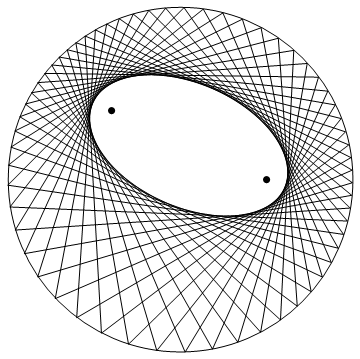"블라쉬케 곱 (Blaschke product)"의 두 판 사이의 차이
둘러보기로 가기
검색하러 가기
Pythagoras0 (토론 | 기여) (→메타데이터: 새 문단) |
Pythagoras0 (토론 | 기여) |
||
| 115번째 줄: | 115번째 줄: | ||
[[분류:복소함수론]] | [[분류:복소함수론]] | ||
| − | == 메타데이터 == | + | ==메타데이터== |
| − | |||
===위키데이터=== | ===위키데이터=== | ||
* ID : [https://www.wikidata.org/wiki/Q4380191 Q4380191] | * ID : [https://www.wikidata.org/wiki/Q4380191 Q4380191] | ||
| + | ===Spacy 패턴 목록=== | ||
| + | * [{'LOWER': 'blaschke'}, {'LEMMA': 'product'}] | ||
2021년 2월 17일 (수) 04:46 기준 최신판
개요
- 다음과 같은 꼴의 뫼비우스 변환들은 단위원을 단위원으로 보내는 전단사 해석함수이다\[B(a,z)=\frac{|a|}{a}\frac{z-a}{1-\bar{a}z}\]
- Blaschke product는 이러한 꼴의 함수들의 유한 또는 무한곱으로 쓰여짐.\[B(z)=\prod_n B(a_n,z)\]
- 단위원에서 정의된 함수로 주어진 점에서 zero 를 갖는 해석함수를 만들기 위해 사용됨
타원과 3차 블라쉬케 곱
- 다음과 같은 3차의 블라쉬케 곱을 생각하자\[B(z)=z\frac{z-a}{1-\bar{a}z}\frac{z-b}{1-\bar{b}z}\]
- 단위원 위의 점 \(\lambda\) 에 대하여, \(B(z)=\lambda\) 의 세 해를 \(z_ 1,z_ 2,z_ 3\) 로 두면, 세 직선 \(\overline{z_ 1z_ 2},\overline{z_ 2 z_ 3},\overline{z_ 1 z_ 3}\) 은 다음 타원에 접한다\[|w-a|+|w-b|=|1-\bar{a}b|\]
- \(a=0.5,b=-0.4+0.4 i\) 로 두고, 다양한 \(\lambda\) 에 대하여 위의 결과를 적용하여 얻은 그림
- [DPR2002] 참조
역사
메모
- [1]http://www.jstor.org/stable/10.2307/3072367
- http://math.stackexchange.com/questions/104806/question-regarding-infinite-blaschke-product
- Math Overflow http://mathoverflow.net/search?q=
관련된 항목들
매스매티카 파일 및 계산 리소스
수학용어번역
- 단어사전
- 발음사전 http://www.forvo.com/search/
사전 형태의 자료
- http://ko.wikipedia.org/wiki/
- http://en.wikipedia.org/wiki/Blaschke_product
- Encyclopaedia of Mathematics
- NIST Digital Library of Mathematical Functions
- The World of Mathematical Equations
리뷰논문, 에세이, 강의노트
- Garcia, Stephan Ramon, Javad Mashreghi, and William T. Ross. “Finite Blaschke Products: A Survey.” arXiv:1512.05444 [math], December 16, 2015. http://arxiv.org/abs/1512.05444.
관련논문
- Fletcher, Alastair. “Blaschke Products and Domains of Ellipticity.” arXiv:1408.2418 [math], August 11, 2014. http://arxiv.org/abs/1408.2418.
- [DPR2002]Daepp, Ulrich, Pamela Gorkin, and Raymond Mortini. 2002. Ellipses and Finite Blaschke Products. The American Mathematical Monthly 109 (9) (November 1): 785-795. doi:10.2307/3072367.
노트
위키데이터
- ID : Q4380191
말뭉치
- Thus, Blaschke's theorem describes the sequences of zeros of all possible Blaschke products.[1]
- P.M. Tamrazov, "Conformal-metric theory of doubly connected domains and the generalized Blaschke product" Soviet Math.[1]
- We present four algorithms to determine whether or not a Blaschke product is a composition of two non-trivial Blaschke products and, if it is, the algorithms suggest what the composition must be.[2]
- The final algorithm looks at inverse images under the Blaschke product.[2]
- Blaschke products were introduced by Wilhelm Blaschke (1915).[3]
- This monograph offers an introduction to finite Blaschke products and their connections to complex analysis, linear algebra, operator theory, matrix analysis, and other fields.[4]
- Deep connections to hyperbolic geometry are explored, as are the mapping properties, zeros, residues, and critical points of finite Blaschke products.[4]
- This book gathers the principal results about Blaschke products heretofore scattered in research papers over the past 70 years and provides an extensive bibliography of over 300 items.[5]
- It is hoped that research workers in and students of function theory will find the book a useful guide and reference to the subject of Blaschke products.[5]
- All examples of Blaschke products constructed so far to prove this result have their zeros located on a ray.[6]
- A Blaschke product always belongs to the set I of inner functions; it has norm 1 and radial limits of modulus 1 almost everywhere.[7]
소스
- ↑ 1.0 1.1 Encyclopedia of Mathematics
- ↑ 2.0 2.1 Decomposing finite Blaschke products
- ↑ Blaschke product
- ↑ 4.0 4.1 Finite Blaschke Products and Their Connections
- ↑ 5.0 5.1 Blaschke Products
- ↑ Girela , Peláez : On the derivative of infinite Blaschke products
- ↑ Some Lemmas on Interpolating Blaschke Products and a Correction
메타데이터
위키데이터
- ID : Q4380191
Spacy 패턴 목록
- [{'LOWER': 'blaschke'}, {'LEMMA': 'product'}]
